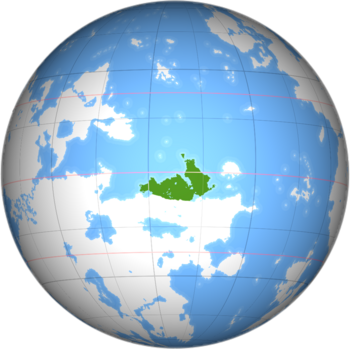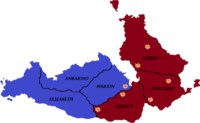Amrelia: Difference between revisions
No edit summary |
No edit summary |
||
| Line 232: | Line 232: | ||
Amrelia spends approximately 2.3% of its GDP on its military. ~spending explained~ | Amrelia spends approximately 2.3% of its GDP on its military. ~spending explained~ | ||
{{Template:Anteria info pages}}[[Category:Anteria]] | |||
Revision as of 04:45, 2 October 2020
Amrelian Federative Republic | |
|---|---|
| Motto: Concordia, Natione, Libertatis (Latin) "Unity, Nation, Liberty" | |
| Anthem: O My Amrelia, Land of Liberty | |
 Location of Amrelia (dark green) in Thrismari | |
| Capital | Whiteford, Federal District |
| Largest city | Willington |
| Official languages | None at the federal level (de jure) English (de facto) |
| Recognised national languages | French, German, Italian, Spanish |
| Ethnic groups (2019) | TBD |
| Demonym(s) | Armelian |
| Government | Federal parliamentary republic |
• President | Chauncey McPherson |
• Consul | Nehemiah Allen (National Union) |
• Vice Consul | Rhys Hammond (Conservative) |
• Chamber of Deputies Speaker | Ephraim Gale (National Union) |
• Chief Justice | Virginia Switzer |
| Legislature | Federal Assembly of the Union |
| Council of States | |
| Chamber of Deputies | |
| Formation | |
• Unification | February 8, 1654 |
• Republic established | August 1, 1780 |
• Federal state | November 2, 1790 |
• Current Constitution | May 16, 2001 |
| Area | |
• Total | 1,208,249 km2 (466,508 sq mi) |
| Population | |
• 2019 estimate | 75,721,796 |
• Density | 62.4/km2 (161.6/sq mi) |
| GDP (nominal) | 2019 estimate |
• Total | $3.964 trillion |
• Per capita | $52,599 |
| HDI (2019) | 0.900 very high |
| Currency | Scudo (₴) (SCU) |
| Time zone | UTC0, +1 (UTC) |
| Date format | mm/dd/yyyy |
| Driving side | right |
| Calling code | +11 |
| Internet TLD | .ar, .afr |
Amrelia, officially the Amrelian Federative Republic (commonly abbreviated AFR), and known more simply as just the Federative Republic or the Federation, is a sovereign state in northeastern Thrismari. Amrelia is composed of 14 federated states and a federal district, Whiteford, which serves as the capital. Willington is the largest city. It is bordered by Trilla Gang Mafia to the south, with a small land border with Norkantion to the southeast, and the Sunadic Ocean to the north, east, and west. Spanning two time zones, the AFR occupies an area of 466,507 sq mi (1,208,249 km²) and has a population of over 75 million people, making it the 17th-most populous country. There is no official language at the federal level, however English is the most commonly spoken language. Other recognized languages include French, Spanish, and Italian.
HISTORY
MAYBE MORE HISTORY
Amrelia is a federal parliamentary representative democracy with a President as head of state and a Consul as head of government. Major urban areas of the nation include Willington, Annesburg, Toussaint, and Lakengren. The country is multi-ethnic and multi-cultural. Roman Catholicism is the majority religion, however the constitution grants freedom of religion to all citizens.
AMRELIA IN THE WORLD TODAY
Etymology
Etymology
History
*very much a work in progress*
Amrelia has existed as a state in its present form since it became a federal republic in 1790 and adopted a constitution which is still in use today. The precursors of Amrelia established a protective alliance at the beginning of the 14th century, forming a loose confederation of states which persisted for centuries.
Early history
Evidence of modern human habitation in the land known as Amrelia today dates back 20,000 years. The earliest known cultural tribes of the area were members of the Lindow and Caerdydd cultures. These cultures developed and flourished during the Late Iron Age from around 500 BC. One of the most important tribal groups in the region was the Amrelii. Wishing to abandon their homes around the O'Creagh Lakes and migrate north, they were eventually defeated by a combined force of the other tribes, forcing the Amrelii to return.
Confederacy
The Confederacy was an alliance among the several regional states that inhabited Amrelia. Effectively governed by Princes of various states, which were de facto monarchs in control of trade and administration, the Confederacy facilitated management of common interests and ensured peace in the valleys and mountain passes. The official founding document of the Confederacy is dated to the year 1305, when the western states of Elizabeth, Franklin, Ambarino, Marion, Murivel, and Quincy agreed to establish an alliance of joint defense as well as remain united on judicial matters. The eastern states of New Bordeaux, Aedirn, Hirane, and Montaro did not sign the document, but would in the coming decades join the united Confederacy. This expansion led to increased power and wealth for the confederation.
*some info*
The Confederacy expanded and gained much reputation with neighboring states. By the mid 16th century, the Confederates controlled land as far west and east as the Sunadic Ocean, south as the Glyswen Mountains, and north as the wetlands of Varoux. Setback occurred, however, in 1590, with the Confederate defeat in the *war name*. This is generally considered to be the beginning of the decline of the loosely-united Confederacy. Combined with the worsening Amrelian economy, inter-state religious conflicts, and growing authoritarianism of the ruling princes and families, the situation in the lands were ripe for civil war.
Amrelian Civil War and unification
The birth of the Kingdom of Amrelia was the result of efforts by Amrelian nationalists and monarchists loyal to the House of Bohannon aiming to establish one unified kingdom composed of all the states in the confederacy. Not only the upper classes and nobility, but also ordinary Amrelians had grown increasingly tired and frustrated with the Confederacy, which was able to maintain order and prosper for more than three centuries but now slowly crumbling into chaos. For more than sixty years civil strife, inequality and economical depression plagued the lands.
During this time, seeing that devolution would bring about the end of their lands, several ruling princes in the Confederacy sought to convene and elect a single ruler which would finally unite Amrelians under a single flag. Not every prince held this view, however. In the summer of 1649, the ruling princes of six states (Elizabeth, Franklin, Ambarino, Marion, Murivel, and Quincy) made a joint declaration requesting that all the princes meet in Marion's capital of Willington to address the crisis unfolding in the confederation. Marion was largely considered the most powerful state thanks to its access to the Gulf of Lannahechee, population and production, making its prince the most likely choice of becoming monarch. The princes of New Bordeaux, Aedirn, Hirane, and Montaro denied the invitation and did not send delegations. Following the Council of Willington, the six princes and their courts unanimously declared that Marion's ruler, Lemuel Bohannon (now styled Ammiras I), was the first monarch under the new Kingdom of Amrelia, and pledged to him full loyalty; the lands of these princes now forming into one nation. When the princes of the eastern states heard of this, they subsequently met with each other and declared war on the kingdom, stating that they would not be forced to unify and would fight for the survival of the Confederacy.
During the fall and winter of 1649, the Kingdom and Confederacy quickly raised volunteer and conscription armies that fought mostly in the east for five years. The King's forces, though suffering a few defeats, ultimately proved superior against the loosely organized but stubborn Confederates. It is believed that around 580,000 Amrelian soldiers and civilians died in the war, making it the deadliest military conflict in Amrelian history. The war ended on February 8, 1654, when the last major Confederate army under General Edward Vansant surrendered to Ammiras I's forces while besieging Aedirn's capital, Ballants. The war proved tragic for the eastern states' land, and a long period of reconstruction began with all of Amrelia now unified under a central government.
Monarchical period
monarchy yay
Revolutionary Amrelia
revs
Federal state
the feds
Modern history
mods
Geography
geo here
Biodiversity
Amrelia is a medgadiverse country with a high number of species. There are over 200 mammal species and 500 species of birds. 230 reptile species have been recorded in the country, including about 130 species of snakes and 60 species of lizards. There are also about 100 species of frogs and thousands of insect species. Thousands of species of fungi have been recorded in the country.
Larger mammals include carnivores such as pumas, jaguars, ocelots, rare bush dogs, and foxes, and herbivores peccaries, tapirs, anteaters, sloths, opossums, and armadillos. Deer are plentiful in the southwest, and many species of New World monkeys are found in the northern rain forests.
Environment
env
Climate
climate
Government and politics
Amrelia is a federal parliamentary republic of 14 states and a Federal District, which also serves as the capital city. It has been a federation since the Second Republic was dissolved in 1790.
In the Amrelian federalist system, citizens are subjected to federal, state, and local governments. The government also has a system of checks-and-balances laid out in the Federal Constitution, which is the most important codified form of law in the nation. It sets out the foundation and boundaries of the federal government as well as basic civil liberties. Proclaimed to the public on November 2, 1790, it formed an indissoluble union of 14 states and the Federal District. It has since been amended several times. Each state has their own constitution grounded in republican principles and is structured in roughly the same fashion as the federal government.
The federal government comprises of three branches:
- Executive: The most powerful official in the executive branch is the Consul, who acts as head of government, Commander-in-Chief of the Armed Forces, controls the federal government, and appoints Federal Ministers. In addition to the Consul, the Amrelian government elects a President who is the head of state and acts in a mainly ceremonial capacity. Furthermore, the Consul appoints a Vice Consul, which is the second highest ranking cabinet member and is usually the leader of the second largest coalition party. The Vice Consul is largely an honorary role, though they do have some constitutional powers, such as replacing the Consul in the event the Consul resigns, dies, or is permanently unable to perform their duties until the next scheduled election date.
- Legislative: Federal legislative power is vested in the bicameral Federal Assembly of the Union which makes federal law, declares war, approves treaties, has the power of the purse, and has the power of impeachment, by which it can remove sitting members of the government. It is comprised of an upper house, the Council of States, and a lower house, the Chamber of Deputies.
- Judicial: The judicial system of Amrelia comprises three types of courts: orindary courts, which deal with criminal and most civil cases, the specialized courts which hear cases related to administrative, labor, social, fiscal, and patent law, and finally constitutional courts which focus on judicial review and constitutional interpretation. The highest of these courts is the Supreme Federal Court of Justice which has 11 justices and can overturn laws they find unconstitutional.
With 67 members, the Council of States is not directly elected by the Amrelian people but appointed by the individual state and Federal District governments. The number of votes each state has is determined by population: states with 2 million inhabitants are granted 4 votes, 7 million inhabitants 6 votes, and 10 million inhabitants 7 votes. The composition of the Council of States is affected by changes in power in the states from elections. Each state delegation is a representation of the state government and reflects the political makeup of the ruling majority of each state legislature. For this reason, the Council of States is one continuous body and has no legislative periods, but for organizational reasons, begins each "year of business" on October 1.
Meanwhile, the Chamber of Deputies is comprised of 339 members each representing an electoral district: one district per 250,000 people and at least 7 Deputies per state. The Chamber is more powerful than the Council of States and only needs the latter's consent for proposed legislation related to revenue shared by the federal and state governments, and the imposition of responsibilities on the states. In practice, however, the agreement of the Council of States in the legislative process is often required, since federal legislation frequently has to be executed by state or local agencies. In the event of disagreement between the two houses, either side can appeal to the Federal Mediation Committee to find a compromise.
Law
As Amrelia is a federal nation, it has federal, state, and local laws. Many states have laws that are not found in other states or at the federal level. States have legal rights to nullify or invalidate any federal law they deem unconstitutional with respect to the Federal Constitution. Also, all laws and governmental procedures are subject to judicial review and any law ruled by the courts to be in violation of the Constitution is voided.
Political divisions
Amrelia comprises 14 federal states which are the principal administrative divisions in the country. These are subdivided into counties and further divided into municipalities. The Federal District contains the capital, Whiteford. The states have a permanent constitutional status and, in comparison with the situation in other countries, a high degree of independence. Under the Federal Constitution, all states are equal in status. Each state has its own constitution as well as its own legislature, government, police and courts.
Citizenship is granted at birth in all states and the Federal District.
| Flag | State | Capital | Population | Area |
|---|---|---|---|---|
| Example | Marion | Willington | 16,542,228 | Example |
| Example | Ambarino | Rio Bravo | 14,215,654 | Example |
| Example | Franklin | Cholla Springs | 12,069,223 | Example |
| Example | Gradobor | Lakengren | 7,644,826 | Example |
| Example | Quincy | Owanjila | 6,076,744 | Example |
| Example | New Bordeaux | Toussaint | 6,000,444 | Example |
| Example | Mortara | Epping | 4,511,208 | Example |
| Example | Aedirn | Rose Valley | 3,133,487 | Example |
| Example | Montaro | Elmswood | 2,874,211 | Example |
| Example | Brenna | Walden | 2,853,025 | Example |
| Example | Hirane | Coliheim | 2,009,373 | Example |
| Example | West Elizabeth | Wimborne | 1,600,179 | Example |
| Example | East Elizabeth | Lyria | 909,509 | Example |
| Example | Murivel | O'Creagh's Run | 782,005 | Example |
| Example | Federal District | Whiteford | 500,124 | Example |
Foreign relations
foreign rel here
Military
The Armed Forces of the Amrelian Federative Republic consist of four official branches: the Army, Amrelia's land warfare branch; the Navy, a blue-water navy with a fleet of 113 commissioned ships, together with the Marine Corps, a highly specialized amphibious light infantry force; the Air Force, a technologically sophisticated air force with a diverse operational fleet consisting of both fixed-wing and rotary aircraft; and the Coast Guard, which operates as coastal defense, search and rescue, and maritime law enforcement. The Armed Forces are commanded by the High Council of National Security, presided over by the Consul who also forms military policy with them. The Federal Assembly has the sole authority to declare war. The Armed Forces are charged with protecting the Amrelian homeland, promoting its global security interests and supporting international peacekeeping efforts.
The military is completely voluntary, although there are provisions in the Constitution that permits the Federal Assembly to impose conscription ages 18-45 during wartime. As of 2019, there are a total of 663,054 personnel in the Armed Forces, of which 178,416 are active. These numbers do not count the National Guard, which has roughly 75,000 total personnel. Broken down, the Army consists of 410,515 (75,000 active), the Air Force 90,427 (29,654 active), the Navy 125,888 (50,655 active), the Marine Corps 21,224 (11,010 active), and the Coast Guard 15,000 (12,097 active).
Amrelia spends approximately 2.3% of its GDP on its military. ~spending explained~







